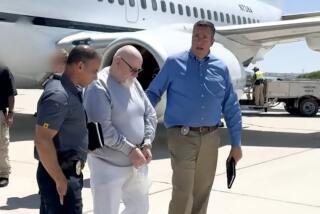Jury Sees More ‘Death List’ Entries : Prosecutors End Case in Kraft Penalty Trial
- Share via
Prosecutors ended their case in the penalty phase of the Randy Steven Kraft murder trial Tuesday, and defense lawyers quickly left to huddle over the question that has haunted them for five years.
Is there anything they possibly can do to save Kraft from the death sentence?
“I’ve thought of nothing else,” Kraft attorney C. Thomas McDonald said outside court recently. “What do you say to jurors who are already convinced your client is a serial killer?”
Superior Court Judge Donald A. McCartin sent the jurors home until July 17, when the defense will begin its side.
Kraft, now 44, was convicted in Santa Ana last month of 16 Orange County murders of young men over an 11-year period. Prosecutors have tied him to 45 murders altogether, which would rank him as perhaps the worst serial killer in the country.
But for the penalty phase, at which jurors must vote on death or life without parole, prosecutors have linked Kraft to just eight new murders: six men in Oregon and two in Michigan.
Kraft’s lawyers barely offered a debate on those killings. They concede that they will have to begin their defense knowing jurors probably believe Kraft killed the eight out-of-state victims too.
The crowning blow came during the noon hour Tuesday, when McCartin refused to block prosecutors from showing jurors more entries from a list found in Kraft’s car. Deputy Dist. Atty. Bryan F. Brown, who claims it is a death list, had shown jurors 13 entries in the guilt phase, and said they represented all but two of the 16 victims in the charges.
The judge allowed him to present seven more list entries Tuesday, which Brown claims represent the eight out-of-state deaths. The double-entry is “GR2” which Brown contends stands for “Grand Rapids 2.” The Michigan victims were killed in Grand Rapids.
The list is so prejudicial, Kraft attorney William J. Kopeny contended, that jurors are not likely to examine the other facts of those murders.
“In view of this jury’s determination that the original entries were a death list . . . then your honor is essentially telling the jurors Mr. Kraft put these victims (from Oregon and Michigan) on his death list as well,” Kopeny argued unsuccessfully.
The new entries are all placed together in the second column on the 61-entry list. Six begin with the word “Portland,” each with an added word: “ELK,” “Blood,” “Denver,” “Hawaii,” “Head,” and “Reserve,” The “Portland” entries are followed by “GR2.”
In the Oregon cases, one victim was from Hawaii and was wearing a shirt with “Hawaii” on it when he died. A second victim was from the Denver area. A third victim was in a military reserve unit. A fourth, the only victim not strangled or choked, was found in a mass of his own blood. A fifth victim was a heavy marijuana user (the “head” connection). Prosecutors do not know what “ELK” means, but claim it refers to the only unidentified body in the Oregon group.
“There were six ‘Portland’ entries on the list and six victims in Oregon; ‘ELK’ must represent the sixth victim, out of the process of elimination if nothing else,” said Deputy Dist. Atty. Thomas M. Goethals.
The list presents a major problem for the defense lawyers, not just because its entries might tie Kraft to specific victims.
Kraft’s lawyer James G. Merwin recently stated in court that “the real purpose of the penalty phase is to examine the defendant’s character and background.” But if the sheet of paper found in Kraft’s car is a death list, what kind of person sits down, pen in hand, and savors the memory, by way of a score card, of how many people he has killed?
“Once the jurors see those Oregon and Michigan entries, the list will literally become the kiss of death for Randy,” said a defense lawyer in the Santa Ana courthouse.
While Kraft’s attorneys will not say anything about their presentation next month, they have said in the past that their penalty-phase defense will be “considerable.”
A widely asked question is whether Kraft himself will finally take the stand. During the guilt phase, Kraft chose not to testify after the judge refused to guarantee he would limit Brown’s cross-examination.
Some say he must testify now to have any chance of saving his life. Others contend that Kraft would rather receive a death sentence than face relentless cross-examination by Brown.
“Randy will go to his grave with a lot of secrets,” said one official involved in the case. “We’ll never know all the people on that list, or how many people he has killed.”
Kraft’s ultimate fate lies with McCartin, but realistically it is the jury’s decision that counts.
McCartin cannot change a verdict of life without parole to death. He does have the authority to reduce a death verdict. But no judge in the county has done that since the new death laws were instituted in 1977 and 1978. McCartin himself has already sentenced six men to Death Row, each time praising the jury’s death verdict as the only correct one.
INTERSTATE DEATH
The most intense period of Randy Steven Kraft’s long murder spree occurred in Oregon and Michigan in late 1982, according to prosecutors’ court papers. In three weeks, they allege, Kraft killed five young men.
“Every time Kraft came to town a dead body turned up,” said one high official involved in the Kraft case.
Here is a breakdown of that period, based primarily on documents and court testimony.
Nov. 23--Kraft, a computer consultant, flies from Los Angeles to Portland for temporary assignment to Lear-Siegler’s Peerless division in Tualitin, south of Portland and three blocks west of Interstate 5. Kraft stays at the Holiday Inn in Wilsonville.
Nov. 24 (morning)--Brian Harold Whitcher, 26, is found dead on a rural road near Interstate 5, less than two miles south of Wilsonville.
Nov. 24 (afternoon)--Kraft flies back to Southern California for the Thanksgiving holiday. He and his roommate traditionally prepared dinner for friends at their Long Beach home.
Dec. 1--Kraft flies from the Long Beach airport to Portland again. This time he stays at the Rodeway Inn near the Peerless plant.
Dec. 3--Anthony Jose Silveira is last seen alive. He told friends he would hitchhike from the coast home to Medford, Ore., which would take him down Interstate 5.
Dec. 4--Kraft drives a rental car from Tualitin, Ore., to Seattle to spend the weekend with two friends. They notice that he is wearing a green fatigue jacket with Silveira’s name on it.
Dec. 5--Kraft flies from Seattle to Grand Rapids, Mich., to attend a seminar at the Amway Grand Plaza Hotel.
Dec. 7 (evening)--Kraft and two colleagues meet 20-year-old Chris Schoenborn at Tootsie’s, a bar at the Amway. Schoenborn is at the hotel for a horticulture convention. They break up shortly before midnight.
Dec. 8 (morning)--Kraft returns to Portland and the Wilsonville Holiday Inn.
Dec. 8 (noon)--A housing supervisor at the Amway Grand finds a set of car keys left in Kraft’s room. Police later discover that they belong to 24-year-old Dennis Patrick Alt, a cousin of Schoenborn’s. Later that day, the Silveira jacket is found in the 11th-floor lounge at the Amway, a few feet from Kraft’s room.
Dec. 9 (early morning)--In Oregon, the body of Lance Trenton Taggs, 19, is found on a road near Interstate 5, less than two miles south of Wilsonville. The road is parallel to the one where Whitcher’s body was found.
Dec. 9 (mid-morning)--In Michigan, the bodies of Schoenborn and Alt are found along a rural road north of Grand Rapids.
Dec. 9 (afternoon)--Kraft, whose assignment at Peerless is done, returns from Portland to Long Beach.
Dec. 18--In Oregon, Silveira’s body is found in a ditch on a rural road off Interstate 5 miles south of the other two bodies. Pathologists say he had been dead at least two weeks.
More to Read
Sign up for Essential California
The most important California stories and recommendations in your inbox every morning.
You may occasionally receive promotional content from the Los Angeles Times.









